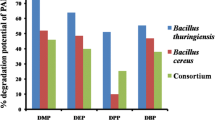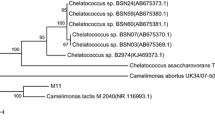Abstract
Dibutyl phthalate (DBP) is a widely used plasticizer, whose presence in the environment as a pollutant raises concern because of its endocrine-disrupting toxicity. Growth kinetics, glucose uptake, biodegradation constant of DBP (k), half-life of DBP biodegradation (t1/2) and percentage of removal efficiency (%E) were evaluated for Fusarium culmorum grown on media containing glucose and different concentrations of DBP (500 and 1000 mg/l). Intermediate compounds of biodegraded DBP were identified by GC–MS and a novel DBP biodegradation pathway was proposed on the basis of the intermolecular flow of electrons of the intermediates identified using quantum chemical modeling. F. culmorum degraded 99% of both 1000 and 500 mg of DBP/l after an incubation period of 168 and 228 h, respectively. %E was 99.5 and 99.3 for 1000 and 500 mg of DBP/l, respectively. The k was 0.0164 and 0.0231 h−1 for 500 and 1000 mg of DBP/l, respectively. DBP was fully metabolized to fumaric and malic acids, which are compounds that enter into the Krebs cycle. F. culmorum has a promising ability for bioremediation of environments polluted with DBP because it efficiently degrades DBP and uses high concentrations of this compound as carbon and energy source.






Similar content being viewed by others
References
Aguilar-Alvarado Y, Báez-Sánchez MR, Martínez-Carrera D, Ahuactzin-Pérez M, Cuamatzi-Muñoz M, Sánchez C (2015) Mycelial growth and enzymatic activities of fungi isolated from recycled paper wastes grown on di (2-ethylhexyl) phthalate. Pol J Environ Stud 24:1897–1902
Ahuactzin-Pérez M, Torres JL, Rodríguez-Pastrana BR, Soriano-Santos J, Díaz-Godínez G, Díaz R, Tlecuitl-Beristain S, Sánchez C (2014) Fungal biodegradation of dibutyl phthalate and toxicity of its breakdown products on the basis of fungal and bacterial growth. World J Microbiol Biotechnol 30:2811–2819
Ahuactzin-Pérez M, Tlecuitl-Beristain S, García-Dávila J, González-Pérez M, Gutiérrez-Ruíz MC, Sánchez C (2016) Degradation of di (2-ethyl hexyl) phthalate by Fusarium culmorum: kinetics, enzymatic activities and biodegradation pathway based on quantum chemical modeling. Sci Total Environ 566–567:1186–1193
Benjamin S, Pradeep S, Josh MKS, Kumar S, Masai E (2015) A monograph on the remediation of hazardous phthalates. J Hazard Mater 298:58–72
Bhardwaj H, Gupta R, Tiwari A (2012) Microbial population associated with plastic degradation. Sci Rep 1(5):272–275
Bouchiat R, Veignie E, Grizard D, Soebert C, Vigier M, Rafin C (2015) Ability of filamentous fungi to degrade four emergent water priority pollutants. Desalin Water Treat 57:1–7
Canavati-Alatorre MS, Águila I, Barraza-Soltero IK, Castillón E, Correa-Barrón AL, Sánchez-López E, Conde-Ávila V, González-Márquez A, Méndez-Iturbide D, Ruvalcaba D, Sánchez C (2016) Growth and cutinase activity of Fusarium culmorum grown in solid-state fermentation. Mex J Biotechnol 1(2):8–19
Chen X, Xu S, Tan T, Lee ST, Cheng SH, Lee FWF, Xu SJL, Ho KC (2014) Toxicity and estrogenic endocrine disrupting activity of phthalates and their mixtures. Int J Environ Res Public Health 11:3156–3168
Chhaya U, Gupte A (2013) Possible role of laccase from Fusarium incarnatum UC-14 in bioremediation of bisphenol A using reverse micelles system. J Hazard Mater 254–255:149–156
Córdoba-Sosa G, Torres JL, Ahuactzin-Pérez M, Díaz-Godínez G, Díaz R, Sánchez C (2014) Growth of Pleurotus ostreatus ATCC 3526 in different concentrations of di (2-ethylhexyl) phthalate in submerged fermentation. JCBPSC 4:96–103
ECB (2003) European Chemicals Bureau, Summary risk assessment report (RAR 003) on dibutyl phthalate (DBP). http://www.greenfacts.org/en/dbp-dibutyl-phthalate/. Accessed 10 Jun 2016
Fang CR, Yao J, Zheng YG, Jiang CJ, Hu LF, Wu Y, Dong-Sheng S (2010) Dibutyl phthalate degradation by Enterobacter sp. T5 isolated from municipal solid waste in landfill bioreactor. Int Biodeterior Biodegrad 64:442–446
Gao J, Chi J (2015) Biodegradation of phthalate acid esters by different marine microalgal species. Mar Pollut Bull 99(1–2):70–75
Gao DW, Wen ZD (2016) Phthalate esters in the environment: a critical review of their occurrence, biodegradation, and removal during wastewater treatment processes. Sci Total Environ 541:986–1001
González-Pérez M (2015) Methyl chloride vs ethyl chloride: a demonstration of quantum chemical theory in accordance with experimental chemical. IJAST 5:11–14
Green Facts (2008) Facts on health and the environment. http://www.greenfacts.org/en/dehp-dietylhexyl-phthalate/l-2/3-effects-environment.htm#3. Accessed 28 Jan 2007
Hu J, Yang Q, Wang JL (2015) Biodegradation of di-n-butyl phthalate in sequencing batch reactor bioaugmented with Micrococcus sp. and the bacterial community analysis. Int J Environ Sci Technol 12:2819–2828
Jin D, Kong X, Liu H, Wang X, Deng Y, Jia M, Xiangyang Y (2016) Characterization and genomic analysis of a highly efficient dibutyl phthalate-degrading bacterium Gordonia sp. strain QH-12. Int J Mol Sci 17(7):1012–1022
Kaneco S, Katsumata H, Suzuki T, Ohta K (2006) Titanium dioxide mediated photocatalytic degradation of dibutyl phthalate in aqueous solution—kinetics, mineralization and reaction mechanism. Chem Eng J 125:59–66
Kim YH, Seo HS, Min J, Kim YC, Ban YH, Han KY, Park JS, Bae KD, Gu MB, Lee J (2007) Enhanced degradation and reduction of toxicity of di 2-ethylhexyl phthalate by Fusarium oxysporum f. sp. pisi cutinase. J Appl Microbiol 102:221–228
Kumar V, Maitra SS (2016) Biodegradation of endocrine disruptor dibutyl phthalate (DBP) by a newly isolated Methylobacillus sp. V29b and the DBP degradation pathway. 3 Biotech 6:200–212
Lee SM, Lee JW, Koo BW, Kim MK, Choi DH, Choi IG (2007) Dibutyl phthalate biodegradation by the white rot fungus, Polyporus brumalis. Biotechnol Bioeng 97:1516–1522
Liang DW, Zhang T, Fang HHP, He J (2008) Phthalates biodegradation in the environment. Appl Microbiol Biotechnol 80:183–198
Meeker JD, Sathyanarayana S, Swan SH (2009) Phthalates and other additives in plastics: human exposure and associated health outcomes. Philos Trans R Soc B 364:2097–2113
Meng X, Niu G, Yang W, Cao X (2015) Di (2-ethylhexyl) phthalate biodegradation and denitrification by a Pseudoxanthomonas sp. strain. Bioresour Technol 180:356–359
Merz KM (2014) Using quantum mechanical approaches to study biological systems. Acc Chem Res 47:2804–2811
Muneer M, Theurich J, Bahnemann D (2001) Titanium dioxide mediated photocatalytic degradation of 1,2-diethyl phthalate. J Photochem Photobiol A 143:213–219
Obruca S, Marova I, Matouskova P, Haronikova A, Lichnova A (2012) Production of lignocellulose-degrading enzymes employing Fusarium solani F-552. Folia Microbiol 57:221–227
Odunola OA, Semire B (2007) Conformational analysis (semi-empirical PM3) and electronic properties of functionalized oligo (hexylpyrroles). Eur J Chem 4:363–371
Patil NK, Kundapur R, Shouche YS, Karegoudar TB (2006) Degradation of a plasticizer, di n-butyl phthalate by Delfia sp. TBKNP-05. Curr Microbiol 52(5):369–374
Pradeep S, Benjamin S (2012) Mycelial fungi completely remediate di (2-ethylhexyl) phthalate, the hazardous plasticizer in PVC blood storage bag. J Hazard Mater 235–236:69–77
Pradeep S, Faseela P, Sarath JMK, Balachandran S, Sudha-Devi R, Benjamin S (2013) Fungal biodegradation of phthalate plasticizer in situ. Biodegradation 24:257–267
Prasad B, Suresh S (2012) Biodegradation of dimethyl phthalate, dibutyl phthalate and their mixture by Variovorax sp. Int J Environ Sci Dev 3:283–288
Rao MA, Scelza R, Scotti R, Gianfreda L (2010) Role of enzymes in the remediation of polluted environments. J Soil Sci Plant Nutr 10(3):333–353
Ren L, Jia Y, Ruth N, Qiao C, Wang J, Zhao B, Yan Y (2016) Biodegradation of phthalic acid esters by a newly isolated Mycobacterium sp. YC-RL4 and the bioprocess with environmental samples. Environ Sci Pollut Res. https://doi.org/10.1007/s11356-016-6829-4
Sánchez C, Téllez-Téllez M, Díaz G, Moore D (2004) Simple staining detects ultrastructural and biochemical differentiation of vegetative hyphae and fruit body initials in colonies of Pleurotus pulmonarius. Lett Appl Microbiol 38(6):483–487
Schwalb MN (1978) Regulation of fruiting. In: Schwalb MN, Miles PG (eds) Genetics and morphogenesis in the basidiomycetes. Academic Press, New York
Suárez-Segundo JL, Vázquez-López D, Torres-García JL, Ahuactzin-Pérez M, Montiel-Martínez N, Tlecuitl-Beristain S, Sánchez C (2013) Growth of colonies and hyphal ultrastructure of filamentous fungi grown on dibutyl phthalate and di (2-ethylhexyl) phthalate. Rev Mex Ing Quim 2:499–504
Tang WJ, Zhang LS, Fang Y, Zhou Y, Ye BC (2016) Biodegradation of phthalate esters by newly isolated Rhizobium sp. LMB-1 and its biochemical pathway of di-n-butyl phthalate. J Appl Microbiol 121(1):177–186
Wackett LP (2014) The metabolic pathways of biodegradation. In: Rosenberg E, DeLong EF, Stackebrandt E, Lory S, Thompson F (eds) The prokaryotes: applied bacteriology and biotechnology. Springer, Berlin, pp 383–393. https://doi.org/10.1007/978-3-642-31331-8_76
Wu XL, Wang YY, Liang RX, Dai QY, Jin DC, Chao WL (2011) Biodegradation of an endocrine-disrupting chemical di-n-butyl phthalate by newly isolated Agrobacterium sp. and the biochemical pathway. Process Biochem 46:1090–1094
Xu XR, Li HB, Gu JD (2005) Biodegradation of an endocrine-disrupting chemical di-n-butyl phthalate ester by Pseudomonas fluorescens B-1. Int Biodeterior Biodegrad 55:9–15
Xu N, Chen PY, Liu L, Zeng YQ, Zhou HX, Li S (2014) Effects of combined exposure to 17a-ethynylestradiol and dibutyl phthalate on the growth and reproduction of adult male zebrafish (Danio rerio). Ecotoxicol Environ Saf 107:61–70
Acknowledgements
We are thankful to the Mexican Council for Science and Technology (CONACyT) for providing a doctoral scholarship (no. 351476) to Miriam Ahuactzin-Pérez.
Author information
Authors and Affiliations
Contributions
MA-P; did the experimental work (Ph.D. thesis). ST-B and ES-J; drew the DBP biodegradation pathway. JG-D; did the GC–MS analysis. MG-P; did the quantum chemical studies. MCG-R; co-supervised MAP Ph.D. thesis and checked the MS. CS; co-supervised MAP Ph.D. thesis and wrote the MS.
Corresponding author
Ethics declarations
Conflict of interest
The authors declare that they have no conflict of interest in the publication.
Electronic supplementary material
Below is the link to the electronic supplementary material.
Rights and permissions
About this article
Cite this article
Ahuactzin-Pérez, M., Tlecuitl-Beristain, S., García-Dávila, J. et al. Mineralization of high concentrations of the endocrine disruptor dibutyl phthalate by Fusarium culmorum. 3 Biotech 8, 42 (2018). https://doi.org/10.1007/s13205-017-1065-2
Received:
Accepted:
Published:
DOI: https://doi.org/10.1007/s13205-017-1065-2




